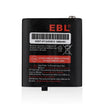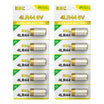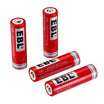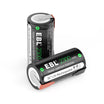Current rechargeable batteries, such as lithium-ion (Li-ion), offer consistent power and acceptable lifespans. Still, these batteries have a relatively low capacity, longer charging periods, and fewer overall charging cycles than graphene batteries of similar dimensions.
Currently, users of d batteries with Li-ion batteries are lucky to keep a charge when needed. The average period to fully recharge a D battery could take several hours. Now imagine if the same battery could hold a charge for a week. If that sounds amazing, imagine the charge occurring in a fraction of the time.
This article will explore the D battery's history and explain where the technology may go soon.
What are D Batteries?
D batteries are a typical dimension of a 'dry cell' battery. These are readily exchangeable models widely utilized in electronic and domestic devices. The term 'dry cell' indicates the battery is unique from the more specialized 'wet cell' batteries, which contain liquid, as the name suggests.
What does a D-size battery look like? Typically, they are heavy barrel-like shapes. The positive contact point on the top of each battery has a distinct nipple-shaped metal cap.
The invention of D batteries occurred in 1898. Today, the battery is sometimes referenced as R20s after their designation by the standards body, the International Electrotechnical Commission (IEC).
D-size batteries are available as both traditional non-rechargeable and rechargeable models.
D Battery Types
Primary batteries can be either Alkaline, Lithium, Zinc Carbon, or Lithium Iron Disulfide (LiFeS2). Zinc Carbon and LiFeS2 are the only pure disposable cells of these chemistries. Alkaline and Lithium have their rechargeable alternatives, as in the case of RAMs and Lithium-ion or rechargeable Lithium. Nickel Metal Hydride (NiMH) and Nickel Cadmium (NiCad) are rechargeable batteries with nominal voltages and other characteristics pre-determined by their specific battery chemistry.
D Battery Dimensions and Specifications
The typical size of a D battery has an approximate size that ranges from 58.0 to 61.50 mm. The diameter varies from approximately 33.0 mm to 34.20 mm. Its weight varies from 160-180 grams. Replacement scopes contain Type 373, FR20, 13LF, 13A, 13D, LR20, R20 MN-1300, MX-1300, and BA-30.
What are the Advantages of a D Battery?
The use of D-sized batteries occurs in high-current applications due to their larger capacity and size for storing energy. The typical use is in large flashlights, radio receivers, transmitters, Nerf Guns, and many other devices that need more power. Rechargeable and non-rechargeable size D batteries are easily accessible.
Image credit: DrFlux
The overall pros of D batteries are:
- Can last up to 4 times longer than other dry cells
- Better performance: ideally used for high-drain applications
- Long battery life: can be repeatedly charged/discharged up to 500-1000 life cycles
- It can remain at high voltage for a more extended period.
What are the Disadvantages of a D Battery?
The primary disadvantage of the D Battery is its larger size. The larger size means the weight of the battery is going to increase. Therefore the weight of items like flashlights drastically increases because of the D battery's weight.
Primary cell batteries must be constantly replaced, making them cheap upfront but expensive over time. Secondary cell batteries are more expensive, especially since you have to buy a battery charger, but these batteries will last longer.
The overall cons of D batteries are:
- The size and weight of the battery
- The expense of purchasing the batteries can become expensive.
- There are risks of chemical dangers
- Appropriate disposal to prevent environmental risks
What is the Future of the D Battery?
The technology for the D Cell Battery has come a long way since 1898. We have established the advantages and disadvantages of this size of the battery. However, looking into the future, how can technology improve its weaknesses?
The battery industry wants to remain viable in the future. The advancement of technology must occur if they will stay in business. Therefore, the success of D batteries depends on how technology improves upon the product of these larger batteries.
Currently, there is a big push by the United States government to improve battery technology. Therefore we should expect research and development to
How to Improve the D Battery?
The future of the D-cell battery needs to improve upon some disadvantages to become a better product. Weight and the hazards associated with producing these batteries are the primary concerns.
Here are some advancements where D batteries might improve in the future.
- NanoBolt Lithium Tungsten Batteries
Researchers at N1 Technologies, Inc are working on battery anode materials by adding tungsten. The polarized location also possesses multi-layered nanotubes with a bond to a copper substrate. Therefore it creates a web-like nanostructure.
The nanostructure comprises an extensive surface area for more ions to stick to during the recharge and discharge processes. Therefore, recharging the NanoBolt lithium tungsten battery will be quicker and supplies more power.
- Zinc-manganese oxide batteries
Exploring conventional beliefs, a squad at DOE's Pacific Northwest National Laboratory saw a startling chemical conversion reaction in a zinc-manganese oxide battery. It can enhance energy density in previous battery technology without raising prices if they manage the procedure.
- Organosilicon Electrolyte Batteries
A concern with lithium batteries is the threat of the electrolyte heat creating a fire or explosion. Exploring safer options than the carbonate-based solvent system in Li-ion batteries, University of Wisconsin-Madison chemistry professors Robert Hamers and Robert West designed organosilicon (OS) liquid solvents. The engineering developments in electrolytes at the molecular level could improve the D-cell battery.
- Gold Nanowire Gel Electrolyte Batteries
Also, seeking a better electrolyte for lithium-ion batteries, the University of California, Irvine, is experimenting with gels. Gels are not as volatile as liquids. They tested coating gold nanowires with manganese dioxide, then cladding them with electrolyte gel. While nanowires are usually too soft to utilize in batteries, these have become resilient. When the researchers charged the consequent electrode, they found it went through 200,000 cycles without losing its capacity to maintain a charge. Comparing the 6,000 cycles in a conventional battery, it is a significant accomplishment.
- TankTwo String Cell™ batteries
The slow recharging process is a barrier to utilizing rechargeable batteries. TankTwo looked at modularizing a battery by turning the charge from hours into minutes. The collection of small independent self-organizing cells consists of a plastic enclosure covered with a conductive material in a String Cell. Therefore this permits the cell to quickly and easily form contact with other cells. An internal processing unit controls the connections in the electrochemical cell, improving the charging speed.
The Bottom Line
The D Battery has many advantages in its use today. Likewise, we should see the use of the battery increase in the future. While technology focuses on making products smaller and more efficient, it will infiltrate into more essential items.
Therefore when the smaller AAA cell batteries improve, so will the technology for the larger batteries.
Now imagine lightweight rechargeable D batteries which can hold a charge for six months to a year on a five-minute charge.
The future looks bright for the D-cell battery.






































Leave a comment
All comments are moderated before being published.
This site is protected by hCaptcha and the hCaptcha Privacy Policy and Terms of Service apply.